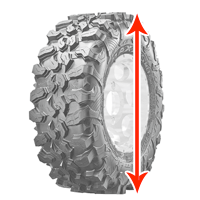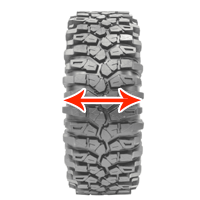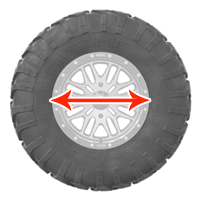Tire Finder
-- select option --


When it comes to buying new tires for your Polaris Ranger, it's essential to consider various factors like the tire dimensions, type, and longevity. Proper tire selection can enhance vehicle performance and safety, and help you tackle any terrain with confidence. Here are some important things to look out for when buying Polaris Ranger tires.
One of the primary considerations is tire dimensions, which include tire diameter, width, and height. Most Polaris Ranger owners prefer 12, 14, or 15-inch tires, while some opt for anything between 9 and 24 inches. The height of the tire is also crucial, and most drivers choose 27 to 32-inch tires, with options between 20 and 35 inches available. Additionally, tire width is another significant factor, and the common width measurements range between 8 and 12 inches.
Choosing the appropriate tire size for your Polaris Ranger is imperative and can be done by consulting your owner's manual. You can also contact the manufacturer directly for recommendations based on your model's intended use. It's best to consider the clearance between the tire and the vehicle's suspension and chassis components, especially if you intend to install larger tires than the factory size.
Additionally, the type of terrain you primarily drive on significantly impacts tire choice. Mud tires are an excellent option for wet or muddy conditions, while sand tires work best for sand dunes. Street-legal tires are perfect for driving on the road. Tire longevity also depends on the tire's construction and type. Hard compound tires tend to last the longest, while radial tires provide a comfortable ride and can last a long time. All-terrain tires are perfect for trails.
Tire construction is also a key consideration when buying Polaris Ranger tires. Materials such as nylon, Kevlar, and steel belts can be used to construct the tires. Nylon is suitable for comfortable on-road use, while Kevlar and steel belts are perfect for rock climbing and other severe off-roading activities. Bias-ply tires are constructed with crisscrossed layers of tire cords, providing a strong and durable tire that can handle heavy loads. However, they may wear unevenly and lack comfort. Radial tires are more flexible with a smoother ride, and belted tires combine the durability of bias-ply tires with the smooth ride of radial tires.
In conclusion, choosing the right set of tires for your Polaris Ranger is critical for ensuring optimal performance, safety, and longevity. By considering the above factors, you can confidently select the best tires for your vehicle and the terrain you intend to traverse.